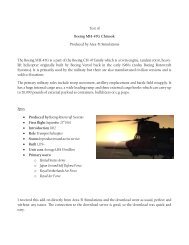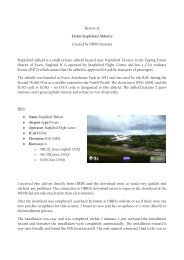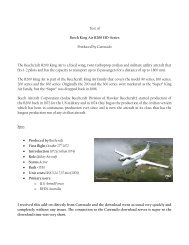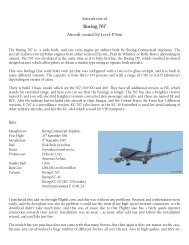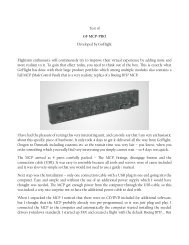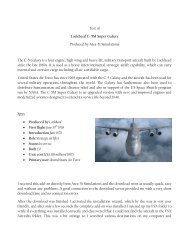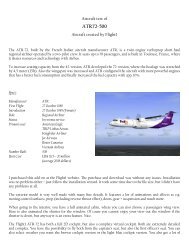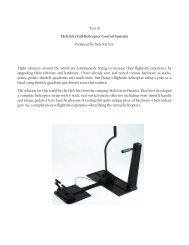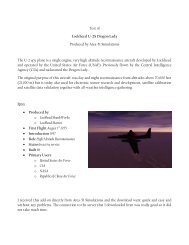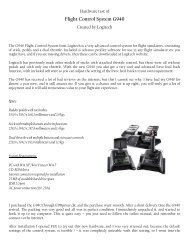Area-51 Simulations Bell OH-58D Kiowa Warrior - Rays Aviation
Area-51 Simulations Bell OH-58D Kiowa Warrior - Rays Aviation
Area-51 Simulations Bell OH-58D Kiowa Warrior - Rays Aviation
Create successful ePaper yourself
Turn your PDF publications into a flip-book with our unique Google optimized e-Paper software.
Test of<br />
<strong>Bell</strong> <strong>OH</strong>-<strong>58D</strong> <strong>Kiowa</strong> <strong>Warrior</strong><br />
Produced by <strong>Area</strong>-<strong>51</strong> <strong>Simulations</strong><br />
The <strong>Bell</strong> <strong>OH</strong>-<strong>58D</strong> <strong>Kiowa</strong> <strong>Warrior</strong> is a single engine and single rotor military helicopter primarily used<br />
for observations of enemy positions and direct fire support. The helicopter is a military enhancement<br />
of the civilian and very popular <strong>Bell</strong> 206A JetRanger and is produced by <strong>Bell</strong> Helicopters for the United<br />
States Army.<br />
There are today built over 2200 units in various versions of the <strong>OH</strong>-58 and the latest version is the D-<br />
model which is used for ground support and recognizance operations. The US Army has used the<br />
<strong>Kiowa</strong> since 1969 and <strong>Bell</strong> has later on also exported versions for several countries as Austria and<br />
Canada – furthermore the <strong>Kiowa</strong> was also produced on license in Australia.<br />
Specs:<br />
Produced by <strong>Bell</strong> Helicopters<br />
First Flight January 10th 1966 (206A)<br />
o (<strong>OH</strong>-<strong>58D</strong> war October 6th 1983)<br />
Introduction May 1969<br />
Role Light Observation Helicopter (L<strong>OH</strong>) / Scout<br />
Status In active service<br />
Primary Users:<br />
o United States Army<br />
o Australian Army<br />
o Republic of China<br />
o Royal Saudi Land Forces<br />
Built 2.200+<br />
Unit Costs <strong>OH</strong>-<strong>58D</strong> US$ 4,9 million (1990 fig)<br />
The first time I became acquainted with the <strong>Kiowa</strong> was in the movie Firebirds with Nicolas Cage and<br />
Tommy Lee Jones and afterwards I have had a great interest in this specific helicopter. I have seen a<br />
few freeware versions for flightsimulator but none which were any good, so when I discovered that<br />
<strong>Area</strong>-<strong>51</strong> <strong>Simulations</strong> had created one, it was simply a must for me to test and review it.
I purchased the <strong>Kiowa</strong> through FSPilotShop and as always the payment and download from that site<br />
was without any issues. The installation went perfectly – quick and easy and I was ready for the fun<br />
part after only a few minutes.<br />
After installation I opened FSX to check if everything was installed properly, and of course it was. I<br />
was very surprised when I discovered that this add-on contains a huge number of various liveries<br />
which were a lot more than what I had expected. Unfortunately the mini pictures are all the same and<br />
that damages the overview a lot, but still it was nice to see so many various liveries. Included in this<br />
add-on is a short manual which can be read in just a few minutes. The manual describes the basics and<br />
how you e.g. activate the night vision gauges.<br />
I started with an external view-around to get a feeling of the model. What I found was a very detailed<br />
model with good textures, a nice finish and multiple animations. The pilots are also modeled quite well<br />
and I saw that the main rotor also do move according to my control inputs which I find as a very<br />
important feature when looking at helicopters. The lighting is good and the textures for the main rotor<br />
are made very nicely.
After viewing this very well made external model I went inside to check out the cockpit. The add-on<br />
features a very well made virtual cockpit but not quite the standard of what I had seen with the<br />
external model. The virtual cockpit is very detailed with fair textures, good depth and a nice finish but<br />
what I am missing is more clickable buttons and switches. I know that this add-on is not the very<br />
newest on the market, but I had expected more integration in the virtual cockpit.<br />
As a very nice plus you do get a lot of details in the virtual cockpit as e.g. the riffle that is placed on the<br />
right side panel and also the possibility to activate night vision gauges and hereby flying the helicopter<br />
at night without any problems. You also have various animations in the virtual cockpit and the gauges<br />
used are also of good quality.<br />
When I started up the engine I noticed the unique sound that the <strong>Bell</strong> 206 makes which I had also<br />
expected because the <strong>Kiowa</strong> is actually a <strong>Bell</strong> 206 converted to a military version. The sound set has<br />
been tweaked to fit the D-model (4-blades) and is fair and fits the model quite nicely. The sound is<br />
clean and clear but it seems that the sound set used internally is not corresponding well with the<br />
sound set used externally which I would have liked it to – meaning that the sound set internally is very<br />
close to the sound set of the default <strong>Bell</strong> B206 internally, but the external sound set is a complete<br />
different sound set, more towards the B406 – I guess that this is due to the D-model configuration.<br />
However the sound set does provide the simmer with added realism and I do like it very much. I tested<br />
the sound set in both stereo and 7.1 surround sound and both works perfectly.<br />
On my first test flight I made take-off from Faa International, Tahiti (NTAA) in French Polynesia. Here<br />
I wanted to test general flight characteristics and low level flight versus medium to high level flight. I<br />
toured the island for about half an hour to get used to the helicopter and then I started various tests<br />
including flight with maximum airspeed, quick turns, cruise, approaches and landings and of course<br />
take-offs. The <strong>Kiowa</strong> has flight characteristics that are very similar to the default <strong>Bell</strong> B206 but with an<br />
improved sensitivity which really adds a lot of realism to this model. If you are not familiar with flying<br />
helicopters, you should choose a different helicopter before trying out your skills on the <strong>Kiowa</strong>.
After flying for about one hour I sat my heading towards the island of Moorea. I made a rapid descent<br />
after cruising over one of the Tahitian peaks and performed a low level, high speed flight across the sea<br />
between Moorea and Tahiti (radio alt +10’). Arriving at Moorea I made a scout approach coming in<br />
low and silently between the trees and landed directly in front on the control tower. This was indeed<br />
an awesome experience and it was a lot of fun trying to fly the <strong>Kiowa</strong> as on a real life mission.
On my second test flight I wanted to try out the night vision gauges combined with a scout approach. I<br />
programmed a flight from Karup AFB (EKKA) to Herning Airport (EKHG), Denmark with time set on<br />
0300 hours = 3:00am. When I got airborne I activated the night vision gauges but nothing happened – I<br />
still had the normal vision which is not usable when flying low between the trees in the middle of the<br />
night. I tried activating the gauges several ways, but nothing seemed to work. I closed down FSX and<br />
opened the manual to see if I had made a mistake. After verifying how to activate the night vision<br />
gauges I opened FSX once again and sat up the same flight one more time. The result was still the same<br />
– no night vision.<br />
My settings for the keyboard are customized for me and I don’t use the default FSX setting. This I<br />
could expect to be why I had some issues here, so I decided to change all settings back to the default<br />
FSX setting and this was much better – I could see that the pilots now actually did put on the gauges<br />
and now it works perfectly.
Conclusion for this add-on is that the model is very well made, good textures, lots of details and<br />
animations and a sound set that fits the model. Good virtual cockpit, a huge number of various liveries<br />
which is really good and all that for a very fair price. The helicopter can be flown by all simmers but I<br />
do recommend that simmers are familiar with minimum the default <strong>Bell</strong> B206.<br />
I do recommend fellow simmers to purchase this add-on, especially if you like military aviation then<br />
this is a must for your virtual hangar. I thank <strong>Area</strong>-<strong>51</strong> <strong>Simulations</strong> for this very well made add-on and I<br />
am very happy to see this specific helicopter for FSX. I rate the <strong>Bell</strong> <strong>OH</strong>-<strong>58D</strong> <strong>Kiowa</strong> <strong>Warrior</strong> with 4/5-<br />
stars<br />
<strong>Rays</strong> <strong>Aviation</strong>
Variants:<br />
<strong>OH</strong>-58A Original version with 4 seats ( 2 pilots and 2 passengers)– The A-model was the original Vietnam version<br />
equipped with a M134 Minigun and a 7.62 mm electronically operated machingun. This version was also exported to The<br />
Canadian Armed Forces and was designated C<strong>OH</strong>-58A but later it was changed to CH-136 <strong>Kiowa</strong><br />
76 units of the <strong>OH</strong>-58A was later modified with an engine upgrade, a thermal imaging system and a communication<br />
package for the police. Also improved navigation equipment and taller skids for the Army National Guard’s for their<br />
Counter-Drug RAID program<br />
<strong>OH</strong>-58B is the export version of the A-model for Austria and Australia. These were later on built on license in Australia<br />
by Commonwealth Aircraft Corporation and designated CA-32 which was actually a <strong>Bell</strong> 206B-1 version = upgraded<br />
engine and longer rotor blades<br />
<strong>OH</strong>-58C is the B-model with a new engine upgrade. There were also installed a new and unique IR damping system on<br />
the exhaust to make the <strong>Kiowa</strong> invisible on various IR tracking systems<br />
Previous versions of the C-model were equipped with flat windows to eliminate sun glare which could be seen by enemies.<br />
This however had a very negative effect for the cockpit view which was a huge strength in the original version<br />
The main instrument panel was also upgraded and was increased with app. 30% to be able to fit larger and more<br />
instruments. NVG (night vision gauges) was also installed and the internal lighting was altered to not effect the NVG. As<br />
an additional upgrade the helicopter was now equipped with a AN/APR-39 radar detector with provides information to<br />
the pilots about hostile anti-aircraft radar systems within a certain range from the helicopter<br />
A few C-models was also equipped with 2 AIM-92 Stinger missiles that could contribute to air-to-air defence – these were<br />
designated <strong>OH</strong>-58C/S and became a part of ATAS (air-to-air-stinger)<br />
<strong>OH</strong>-<strong>58D</strong> The base model for the D-model is <strong>Bell</strong>’s model 406. This version was transferred to the military as a result of<br />
the AHIP program (army helicopter improvement program). The D-model has an upgraded transmission and upgraded<br />
engine that provide the helicopter with sufficient power for what the US Army calls Flight Profile nap-of-theearth.<br />
To support this, the rotor was changed to a 4 bladed rotor which reduced the noise level significantly<br />
Next step in the upgrade was the MMS (mast-mounted sight) that was placed on top of the rotor. To support the MMS the<br />
instrument panel was partly converted to be a glass cockpit including both analogue instruments but now also LCDs.<br />
<strong>Bell</strong> actually also did make a 406CS (combat scout) which was a D-model including all upgrades (MH-<strong>58D</strong>) – All 15<br />
units produced was exported to Saudi Arabia with a small variation – the MMS was replaced with a SAAB-HeliTOW<br />
sight system and the 406CS had removable weapon hard points on each side
The <strong>OH</strong>-<strong>58D</strong> became very popular and task force 118 got their own version – the AH-<strong>58D</strong>. This version was modified with<br />
advanced weapons for support use for Operation Prime Chance – these new weapon systems was later on standard for the<br />
<strong>Kiowa</strong> <strong>Warrior</strong><br />
<strong>OH</strong>-58F is a version that has not yet entered service – it is an upgraded D-model that is expected to remain in service<br />
until 2025. The upgrade includes e.g. a cockpit with sensor upgrades (CASUP) and the MMS will be replaced by a nose<br />
mounted targeting and surveillance (similar to the AH-64D Apache Longbow)<br />
<strong>OH</strong>-58X was a modification of the D-model with improved stealth and a nose mounted McDonnell-Douglas Electronics<br />
System turret providing the pilots with a night system including a Kodak FLIR system with 30 degrees angle view. The<br />
instrument systems was moved to the nose to give enough space for a passenger seat – NOTE that this model was never<br />
built – only exists on the drawing board
Specifications for D-model<br />
General<br />
<br />
<br />
<br />
<br />
<br />
<br />
<br />
Crew: 2 pilots<br />
Length: 42 ft 2 in (12,85m)<br />
Rotor diameter: 35 ft 0 in (10,67m)<br />
Hight: 12 ft 10 5/8 in (3,93m)<br />
Empty weight: 3.829 lb (1.737 kg)<br />
MTOW: 5.500 lb (2.495 kg)<br />
Engine: 1x Rolls-Royce T703-AD-700A or 250-C30R/3 Turboshaft, 650 hp (485 kW)<br />
Performance<br />
<br />
<br />
<br />
<br />
Max speed: 130 kts (241 km/t)<br />
Cruise speed: 110 kts (204 km/t)<br />
Range: 299 nmi (555 km)<br />
Service Ceiling: 15.000 ft (4.575m)<br />
Weapons<br />
<br />
<br />
<br />
<br />
AGM-114 Hellfire anti-tank missiles<br />
Hydra 70 rockets<br />
M296 or M3P 50 caliber (12,7 mm) machinegun<br />
AIM-92 Stinger air-to-air missiles (not in use any more)



